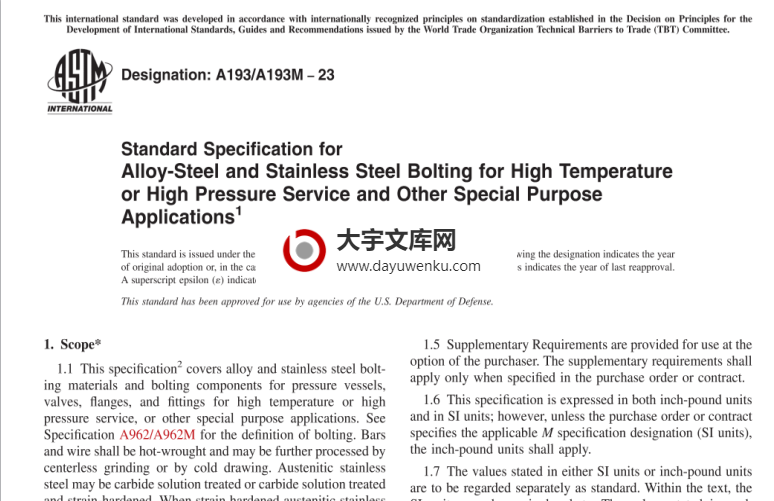ASTM A193/A193M-23 pdf free download 合金钢和不锈钢螺栓用于高温或高压服务及其他特殊用途的标准规范
ASTM A193/A193M-23 pdf download, Standard Specification for Alloy-Steel and Stainless Steel Bolting for High Temperature or High Pressure Service and Other Special Purpose Applications.
合金钢和不锈钢螺栓用于高温或高压服务及其他特殊用途的标准规范
This specification ASTM A193/A193M-23 covers alloy steel and stainless steel bolting material for pressure vessels, valves, flanges, and fittings for high temperature or high pressure service, or other special purpose applications. Ferritic steels shall be properly heat treated as best suits the high temperature characteristics of each grade. Immediately after rolling or forging, the bolting material shall be allowed to cool to a temperature below the cooling transformation range. The chemical composition requirements for each alloy are presented in details. The steel shall not contain an unspecified element for ordered grade to the extent that the steel conforms to the requirements of another grade for which that element is a specified element. The tensile property and hardness property requirements are discussed, the tensile property requirement is highlighted by a full size fasteners, wedge tensile testing.
该规范涵盖了用于压力容器、阀门、法兰和配件的合金钢和不锈钢螺栓材料,用于高温或高压服务,或其他特殊用途应用。铁素体钢应根据每种牌号的高温特性进行适当的热处理。在轧制或锻造后,螺栓材料应冷却至低于冷却转变范围的温度。每种合金的化学成分要求均详细列出。钢材不得含有未指定的元素,以至于钢材符合另一种规定该元素为指定元素的牌号的要求。讨论了拉伸性能和硬度性能要求,拉伸性能要求通过全尺寸紧固件、楔形拉伸测试突出显示。
Scope
1.1 This specification2 covers alloy and stainless steel bolting materials and bolting components for pressure vessels, valves, flanges, and fittings for high temperature or high pressure service, or other special purpose applications. See Specification A962/A962M for the definition of bolting. Bars and wire shall be hot-wrought and may be further processed by centerless grinding or by cold drawing. Austenitic stainless steel may be carbide solution treated or carbide solution treated and strain-hardened. When strain hardened austenitic stainless steel is ordered, the purchaser should take special care to ensure that Appendix X1 is thoroughly understood.
1.2 Several grades are covered, including ferritic steels and austenitic stainless steels designated B5, B8, and so forth. Selection will depend upon design, service conditions, mechanical properties, and high temperature characteristics.
1.3 The following referenced general requirements are indispensable for application of this specification: Specification A962/A962M.
NOTE 1: The committee formulating this specification has included several steel types that have been rather extensively used for the present purpose. Other compositions will be considered for inclusion by the committee from time to time as the need becomes apparent.
NOTE 2: For grades of alloy-steel bolting suitable for use at the lower range of high temperature applications, reference should be made to Specification A354.
NOTE 3: For grades of alloy-steel bolting suitable for use in low temperature applications, reference should be made to Specification A320/A320M.
1.4 Nuts for use with bolting are covered in Section 13.
1.5 Supplementary Requirements are provided for use at the option of the purchaser. The supplementary requirements shall apply only when specified in the purchase order or contract.
1.6 This specification is expressed in both inch-pound units and in SI units; however, unless the purchase order or contract specifies the applicable M specification designation (SI units), the inch-pound units shall apply.
1.7 The values stated in either SI units or inch-pound units are to be regarded separately as standard. Within the text, the SI units are shown in brackets. The values stated in each system may not be exact equivalents; therefore, each system shall be used independently of the other. Combining values from the two systems may result in non-conformance with the standard.
1.8 This international standard was developed in accordance with internationally recognized principles on standardization established in the Decision on Principles for the Development of International Standards, Guides and Recommendations issued by the World Trade Organization Technical Barriers to Trade (TBT) Committee.

下载信息
进入下载地址列表





